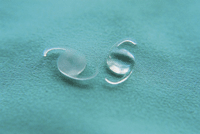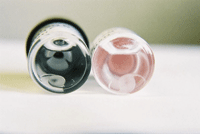David Walker explains where he feels major development in intraocular lenses has taken place
The recent article 'A brief review of intraocular lenses' (optician June 10, 2005 Vol 229) gave a good perspective of the development of some aspects of intraocular lenses. Such articles are of great benefit to the optical practitioner and enable a more pro-active response to a patient's questions or indeed problems. This article will look behind some of the highlights of the recent review and supplement some of the conclusions with scientific data which may mean they can be considered with a higher level of confidence.
THE WORLD MARKET
It has been reported that cataract extraction and intraocular lens replacement is the most performed,1,2 and statistically safest and most successful surgical procedures performed in the world.3,4,5 This is certainly a point that can be emphasised to a patient on referral or prior to a procedure. The total number of procedures conducted worldwide is estimated at 15 million per annum. According to Optistock, the cataract/intraocular lens (IOL) market experienced an approximate 5 per cent worldwide growth in 2003, or $2.3 billion in global sales.6 There is no published definitive market data; this estimation is reached by analysis of country data, company reports, published articles and analysis of data available from the internet.
 |
| Figure 1. An opacified IOL and a normal IOL. The lens opacified in the vial following a reaction with the packaging materials. Both are unsued lenses |
The breakdown of this market is equally intriguing, and is greatly influenced by regional developments. The market statistics clearly indicate that over half of all lenses implanted are made from PMMA, the vast majority of those being manufactured from Perspex CQ UV or its only acceptable successor Vistacryl CQ UV. The majority of these lenses are used in the developing world. PMMA lenses are produced by almost every intraocular lens laboratory worldwide.
All the multinational companies still sell considerable number of PMMA intraocular lenses. In the developed world the majority of lenses implanted are of the foldable variety. The June 10 article did not refer to the hydrophobic foldable lens, which is responsible for an estimated 65 per cent of the foldable market, or the silicone lens which has a much smaller (single figure) percentage. The silicone lens was the first of the foldable lenses and was initially very popular. Popularity was affected, probably unfairly, by the adverse publicity surrounding the failure of some silicone breast implants.
THE HYDROPHOBIC IOL
The hydrophobic lens is presently the most important foldable intraocular lens in market share terms. After the silicone lens, the Acrysof, from Alcon Surgical, was the first foldable lens to enter the market. The lens launch was backed by fully comprehensive training and development programme for the ophthalmologist and was the first approved for use in the US by the Food and Drug Administration (FDA). This gave the hydrophobic a distinct marketing advantage over other foldable lenses. Some of the other multi-national companies have hydrophobic lenses on the market, but the series of patents that surround the product make entry into the market a formidable barrier.
 |
| Figure 2. The same lenses in the original packaging. Note the red bung in the opacified lens vial |
To understand the hydrophobic lens is somewhat difficult to a person more used to the principle of soft hydrophilic contact lenses. The hydrophobic lens is fully flexible at both room and body temperature. This inherent flexibility means that the most appropriate commercial way to manufacture a lens in volume is by cast moulding. The only way to lathe a hydrophobic material is by using cryo-lathing techniques, some materials requiring a temperature of -40oC. Hoya has recently launched the first lathed hydrophobic lens.
The second problem to overcome in hydrophobic lenses is the formation of vacuoles. This phenomenon occurs when the lens is taken to body temperature and there is evidence of bubble-like contamination inside the matrix of the polymer. If these vacuoles, which seem to be random in formation, are found in the optics of the lens, then vision may be compromised. These vacuoles can be observed with the intraocular lens in situ, using a slit lamp.
All hydrophobic materials suffer the vacuole problem, to some degree or another, but it can be overcome with clever polymer engineering. The problem was reported with early Acrysof lenses although it now seems solved with that lens. Vista Optics has developed a vacuole-free hydrophobic material that can be lathed at around -10oC and that does not transgress any of the published patents.
THE HYDROPHILIC IOL
The majority of intraocular lens manufacturing companies required materials that depended on lathing technology and the majority of the big players were involved in the development of this technology throughout the early 1990s. The first generally available hydrophilic materials were developed by the Vista Optics' team headed by Dr Howard Gee with the co-operation of several European intraocular lens manufacturers and Professor Brian Tighe's team at the University of Aston in Birmingham. This programme led to the launch of this type of lens in the mid-1990s.
Similar developments were under way at Bausch & Lomb which led to the launch of its Hydroview lens.
LENS OPACIFICATION
There are now several generic hydrophilic acrylic materials marketed throughout the world. This material range suffered a setback with reports of unexplained opacification of the implanted lens. There are some published articles suggesting the cause of this opacification but
the majority of evidence is unsubstantiated.8, 9,10 Several reports were commissioned by Vista Optics in relation to this problem. In one report Professor Brian Briscoe of Imperial College London stated 'It has been suggested that variations in cross-link density may occur and that an impurity such as methacrylic acid (MAA) could be responsible for the opacification [two external reports cited]. This is pure speculation.'11
There is no scientific evidence, merely conjecture, that particular polymerisation techniques make a polymer less prone to opacification.
Similarly of the chance of contamination by methacrylic acid Professor Tighe states: 'There is to my knowledge no documentation on the causes of IOL opacification that implicates MAA in HEMA-containing polymers or any other type of polymer as a cause of IOL opacification.'12
It is abundantly clear that an improperly polymerised material will not be suitable for an intraocular lens. It must be equally obvious that an improperly polymerised material would not allow a high specification lens to be manufactured in the first place. Third party13,14 results show that there is little difference between materials manufactured in rods or those in buttons, although the spread of power during manufacturing clearly indicates that the rod-made product is statistically slightly more consistent.
CAUSES OF OPACIFICATION
Opacification appears to occur as a result of a complex inter-relationship between several key areas. Details of such inter-relationships have been published by several experts15,16,17 and verified by Professor Tighe18 and Professor Briscoe19 both of whom are acknowledged experts in the polymer materials field. The scientific evidence now clearly points to the opacification of hydrophilic acrylic intraocular lenses being clearly caused by an interaction between the packaging materials and the lens itself (Figures 1 and 2).
The lens processing and packaging products used in manufacture were at the time considered suitable for this new generation of materials.
With the increased lens manufacturing knowledge and experience gained over the past five years, these earlier practices are now considered unacceptable.20 Forensic examination using sophisticated investigative analytical techniques, such as LIMA techniques,21 showed that the rubber bungs used in the storage vials and stoppers elute various elements and compounds. These were also found to be present on unused and explanted opacified lenses. It is clear that these compounds were instrumental in causing lens opacification.22
The majority, if not all, of the cases of opacification reported are from lenses of early manufacture (even though it seems more recent, this phenomenon is highlighted because of recent legal announcements rather than the date of the event). Lenses from several manufacturers and different polymers have suffered this problem. All of the reported cases of opacified hydrophilic acrylic intraocular lenses have been manufactured by companies from the US.
There have been many millions of hydrophilic acrylic intraocular lenses implanted over the past years and the vast majority of users have had excellent results from the benefits of this excellent modality of intraocular lens. Once this point is clearly understood the stigma attached by some to this modality will disappear and the market penetration will increase.
The market development of the hydrophilic intraocular lens is clearly not helped by unsubstantiated comments disguised as scientific information.
THE FUTURE
It takes a very long time to develop a new material and the testing programmes involved before the launch of a new lens are extensive. It is unlikely that any novel materials are just around the corner. With the advent of the foldable materials and advances in lathing and other lens production technology the next period of development will concentrate on lens design.
This technology will lead to the improvement of visual acuity and introduction of improved lenses for presbyopic correction. The possibility of using wave front technology developments should not be discounted.
In material development the ability to add tints to protect the inner eye or enhance visual contrast will be important. The availability of lathed hydrophobic designs will mean a greater availability of different lens designs.
The increased confidence in the intraocular lens will no doubt, over time, herald the more widespread introduction of the implanted contact lens.
Meanwhile, in the developing world the continued lack of advanced surgical equipment will mean that the more advanced materials will not be required, and the use of PMMA will continue at least until 2020 when, hopefully, the programme will significantly have reduced those preventably blind because of cataract problems.
References
